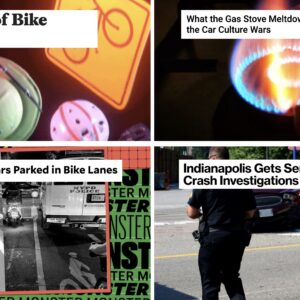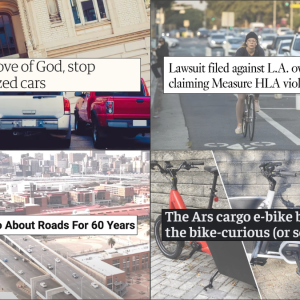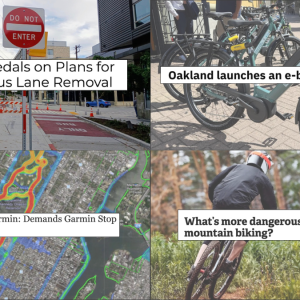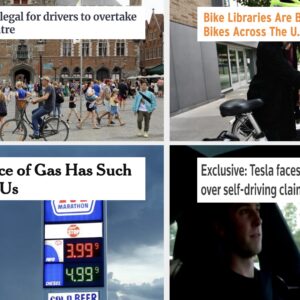
(Image: Garmin.)
Here’s the bike news that caught our eyes this week:
Garmin camera: The GPS maker is competing with GoPro with a new $400 action camera that connects wirelessly to a mobile app on your phone and the company’s other hardware. There’s a $300 version with fewer bells and whistles.
Helmet lawsuit: Easton-Bell Sports won a lawsuit brought by a man who suffered brain injuries while completing a long ride. The California company said he’d been wearing it improperly.
Athlete killed: A promising British hockey star died after crashing the $30,000 BMW that his mother had just bought him because she thought it’d be safer than biking to work.
Bizzare bike attack: Wildest story of the week has got to be the young businesswoman who was biking in Chicago when a man in the back seat of a speeding purple SUV grabbed her messenger bag and towed her into a parked car.
Hit and run epidemic: Half of all car crashes in Los Angeles are hit-and-runs. An LAPD detective says one major factor is that people who entered the country illegally are terrified of the entire justice system.
Intelligent bike: The $2,600 Vanmoof offers an onboard computer, GPS tracking (to find your lost bike) and an electric assist system that knows how much help you need at a given time.
Cars that make people drive worse: Bigger cars and more expensive cars make people more aggressive.
“Americans growing less concerned about dangerous driving behaviors”: Apparently the AAA doesn’t own any stock photos of people in cars looking concerned. Four truly scary trends here.
Mandatory parking lots: Sightline Institute founder Alan Durning lists five ways parking minimums raise rents.
Carfree street counter: Two weeks after cars were banned from Goldsmiths Row, London, it’s drawing 5,000 bikes a day (that’s about as many crossings as the Steel and Burnside bridges put together).
Amazon cycle track: Under a deal negotiated with Seattle as part of a growth plan, Amazon will fund a two-block protected bike lane.
Third truck death in SF: All three deaths of people on bikes in San Francisco this year have involved large trucks in the same construction-heavy area of town.
Global road deaths, mapped: This new map seems suspiciously similar to this one.
Texas takes up bikes: “It’s not this sort of fringe tree-hugger issue anymore,” Alta Planning’s new woman in Dallas tells the NYT. San Antonio, Houston and Fort Worth all have bikesharing and Austin is next.
Bikes are the new sewers: “Cycling offers us, for the first time in more than a century and a half, the chance to build an infrastructure that will bring with it significant public health improvements.”
Bike tourism: Bike-related tourism brings $88 million a year to Arizona. Keep pedaling, Phoenix — it’s $400 million here.
Oh dear: Chicago condo owners worry that bikeshare racks will bring an “‘invasion’ of people” to their area.
Bikesharing helps bike shops: That’s the story at NYC bike shops that don’t rely completely on rental revenue.
Divvy turnaround: Three months after a preemptive series of pans of Chicago’s new bikeshare system, the Tribune’s transpo reporter rows back his complaints and changes his tune.
Citi Bike bar crawl: “Beats paying for a cab,” the NYT reports.
Police problems: As Doug Gordon of Brooklyn Spoke put it, one traffic safety problem Mike Bloomberg has never tackled is the NYPD.
Church vetoes bike lane: D.C. political leaders nixed their own DOT’s plan to cut street parking in front of a historically black church to make room for a protected bike lane.
Handsfree distraction: Driving without a phone in your hand is just as distracting as driving with one.
Bad bike sign: Bike Delaware makes a persuasive case against “Share the road” as a message for street signs.
Speaking of which, your video of the week gets some sort of award for the most patronizing “bike safety” offering I’ve seen in a while:
If you come across a noteworthy bicycle story, send it in via email, Tweet @bikeportland, or whatever else and we’ll consider adding it to next Monday’s roundup.







Thanks for reading.
BikePortland has served this community with independent community journalism since 2005. We rely on subscriptions from readers like you to survive. Your financial support is vital in keeping this valuable resource alive and well.
Please subscribe today to strengthen and expand our work.
Too bad the Bicycle Retailer story didn’t report more details about the helmet failure claim case brought against Easton-Bell, which the company won. I wonder if there may have been something else besides scratches on the helmet, that indicated to the company that the helmet was worn to high on the plaintiff’s head
“…According to a press statement by Easton-Bell Sports’ law firm, Yukevich-Cavanaugh, the defense was able to point to scratch marks on Sohn’s helmet that invalidated the crash reconstruction presented by Sohn’s attorneys. …” bicycle retailer http://www.bicycleretailer.com/north-america/2013/08/21/bell-wins-lawsuit-filed-cash-victim#.UhudMH_0vaL
If the scratch marks were on the downward facing part of the edge of the helmet, it would indicate that it was too loose, and slid up the side of his head when he struck the pavement. Scratches on the horizontal or top sides of the helmet would indicate a crash where the helmet was likely worn properly.
Just a guess, but I’m basing it on the countless riders that I have seen with improperly fitting helmets. Always too loose, so they can slide around, exposing your head.
I don’t hear the patronizing tone in the video linked. I suppose if you’re looking for it, you’ll find it though.
I think it’s more of a “well, duh” tone than anything. It’s difficult to imagine anyone gleaning any new information from that, even if they were able to sit through it.
That plus it is a pro-automobile organization pretending to “help” people who bike do so safely, and all but ignoring the elephant in the room – poor drivers and traffic laws. What, about 10% of the video is focused on how people who drive can do so more safely?
It’s like jurisdictions that require helmets to “help those bikers be safe” and ignoring infrastructure, traffic law improvement/enforcement, and everything else.
i think it was more like 5% Not to mention the entire thing appears to have been shot in a suburban office park with a guy on a time trial bike.
You and some others commenting here disagreeing with AAA’s effort, could get busy and produce your own bike safety video consisting of suggestions and advice you believe should be offered instead of that which AAA is offering in its’ video.
They “could” do as you suggest, but they “could” also meditate, go hunting, play basketball, commit suicide, write a book, or do anything else possible, including what they are already doing. I say that, because it seems to me your comment was along the lines of “don’t complain unless you can do better”, as though you were trying to dismiss their criticism as shameful or something.
Making a video would fulfill a different function than does criticizing the one that already exists. We can appreciate the merits of AAA’s efforts while still wishing their efforts, given their resources and wide influence, would do more, and voicing criticisms to promote such thinking.
I think it’s because it’s not “bike safety” so much as it is “how to avoid/survive a motor vehicle crash”… they mention nothing about checking your brakes or your tire’s air pressure… yet they advise that you wear a helmet and bright clothing that likely won’t help…
Urrgghhhh… what really got to me on this video is the cyclist’s position on the road. Usually 6″ from the cement gutter or riding in it. Really?
It’s as if cyclist are only worthy of road real estate table scraps.
I prefer to take a more assertive position in the road rather than encouraging some drivers to pinch me further to the curb.
Oh, and AAA should also advise their drivers to wear helmets. It would definitely cut down on head injuries during their high speed crashes that are so much more common.
I still think ODOT’s Bike Survival Guide is worse in the patronizing dept. I found this one mostly just annoying as Spiffy pointed out below. The sign at the intersection: AAA drive? I hate branding.
I don’t either. As mentioned by others, the real issues with this video are the cyclist’s poor lane position, a lack of notifying drivers that cyclists may suddenly change position to avoid obstacles/hazards a motorist can’t see, and also that regardless of visibility, it is everyone’s responsibility to operate their vehicle in a way that they can safely stop without hitting someone in front of them. (i.e. following distance) Overall, though, the AAA video isn’t really worse than any other safety video out there.
The AAA survey is shocking and probably deserves its own article.
Fooling around on websites of German versions of the AAA I found the following – from the VCD, which bills itself as The Eco-Automobile Club of Germany. Under ‘bicycles’ they have this to say:
Bicycles: the winning ticket
Bicycling is good, in many respects: It is fun, provides exercise, and is healthy. Bicyclists are flexible, and in cities they can often get to their destination more quickly than in a car or bus, because congestion and looking for parking are not a problem. The bicycle is therefore the optimal mode in the city.
People who bike get around independently and inexpensively, and actively protect the climate: each kilometer ridden by bike rather than the car saves the climate 140g/km of CO2. Furthermore bicycling causes neither noise nor exhaust or particulates, and is thus, along with walking, the most environmentally friendly way to get around.
This is what the VCD demands
We demand more room for bikes on the streets, more money for higher quality bicycle infrastructure. The system conditions for biking must be just as good as for driving. This includes a well-developed network of accommodations, more secure options for storing/locking bikes, bike parking garages, and a nationally standardized system of rules governing the taking of bicycles onto all public transit for free
If everyone jointly advocates for bicyclists, the bicycle will soon be the natural, everyday choice for getting to work, to school, and for shopping.
Learn more about the advantages of bicycling, bicycling at work/on the job, bicycle politics, e-bikes, and about our position on helmet requirements. (all of those topics were links to other pages).
http://www.vcd.org/fahrrad.html
pretty smart of AAA to disable comments and ratings on their “Bike Safety – Introduction to Bike Safety and Sharing the Road” video…
Take down request as hate speech?
I’ve got a new problem with the helmet industry after this. They take no responsibility for a “misused” safety product using the design that they certify.
It’s hard not to feel like a dupe. Surviving a fall while wearing a helmet—which I have done—gives testimony to its life-saving virtues, as if we’d go back to prove them by repeating the accident without a helmet. Victims who wear helmets, however, take the blame for improper use, which is never the fault of the design that the manufacturer certified for safety. Heads I win, tails you lose.
“…They take no responsibility for a “misused” safety product using the design that they certify. …” Champs
Bike helmets generally come with instructions about proper fitting and adjustment required in order for the wearer to benefit from their helmets’ design. Maybe you have some ideas of your own about other fair ways bike helmet manufacturers could take responsibility for problems occurring from helmet users misusing bike helmet manufacturers’ products.
They also come with disclaimers and warnings in the instruction packets and stickers within the helmet which no matter how they are worded is summed up as “they aren’t guaranteed to work”.
As long as they publish such disclaimers in the instruction booklets, they basically remove themselves from any kind of liability, even if the helmet was worn properly.
That is why many of us have always said that the helmet is a fashion accessory and not a piece of safety equipment.
Many bike lock manufactures have insurance policies on their products even though they know they wont work all the time. Why doesn’t the bike helmet companies offer a similar option for their products? Perhaps because it would cost more in legal fees fighting everyone that made a claim? Or they just don’t want the press of all the claims they’d have to pay out which would of course be bad press for them. Or is it because they know they don’t work. Take your pick or even come up with another reason, but not a single reason why they wouldn’t do this speaks very highly of their perception of how well their product works.
The only helmet design that would actually work would be a face shielded motorcycle helmet (which was the bicycle standard back when the standards were first made in the late 60’s or early 70’s). But of course even the safety standards of those have been coming under fire recently.
>> video of the week gets some sort of award for the most patronizing “bike safety” offering I’ve seen in a while
I saw nothing wrong with it unless you are just looking for something to bitch about. Sure it’s geared towards new riders, and most of us aren’t, but geeze there are many more important things you could focus on MA. Ignore the fluff.
Helmet cams: I haven’t confirmed this, but I recently heard that Contour (at one time GoPro’s biggest competitor) has quietly folded. I can’t help but think that Garmin’s entry into the market may have hastened that. (Yes, I have 2 Contour cams.) If anyone out there has Contour cams and needs accessories, mounts, etc, I’d snatch them up now.
Interesting. I wrote to WA-based Contour several years ago when they first started sharing my idea about creating a camera that was ANT+ compatible and overlaid programmable data onto the video stream to be recorded for later analysis. It was just an idea I had while doing lots of steep hill training in a scenic area where I was too distracted to pay attention to my Edge (and had too little time to upload and review in software) and I figured it wouldn’t go anywhere (maybe some elite pros might find it handy). For giggles I also penned it into an Oregon Scientific innovation competition. I don’t know if Garmin plans to do anything along these lines (not really a game-changing idea, I confess), but I find it interesting they are entering this market. Knowing the company I suspect they will do something to differentiate from Go-Pro, who is currently growing and hiring in the SF bay area.
Before long helmet cams will all be designed and built overseas… at a price we won’t be able to pass up.
Hilarious – the VeloNews article finally came up in the other window and describes the technology as “game-changing“… 😉
Oregon Scientific has a helmel camera with two lenses. I think it would be great for getting license plates, recording conversations etc.